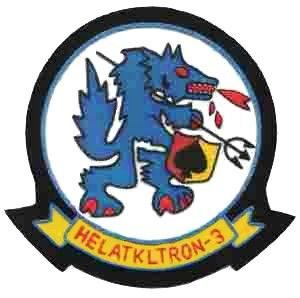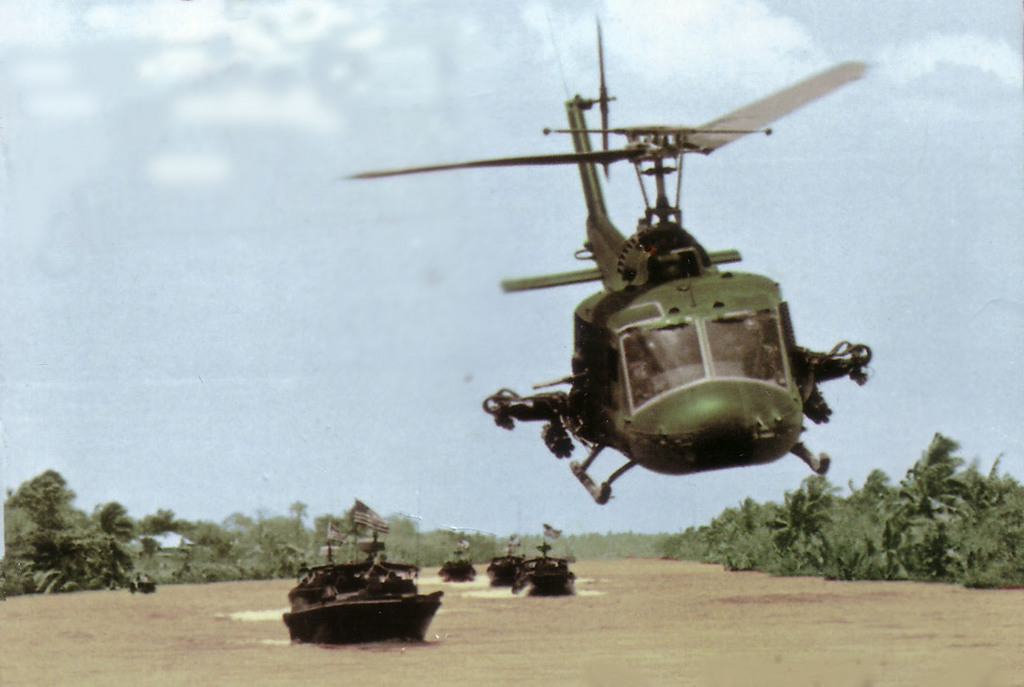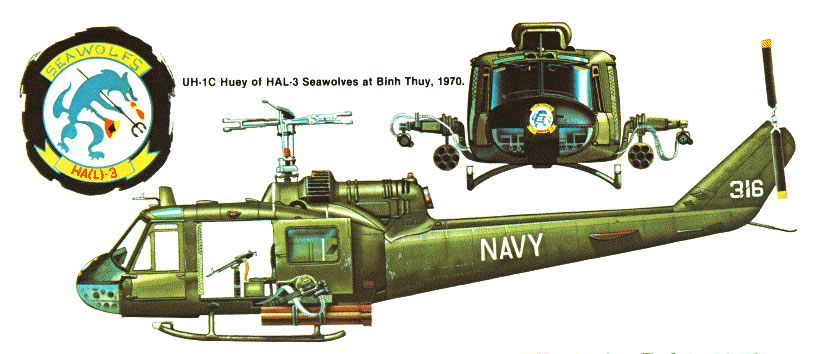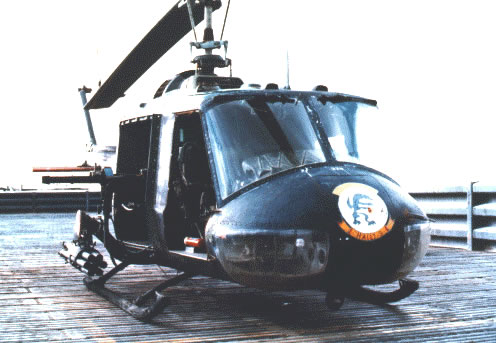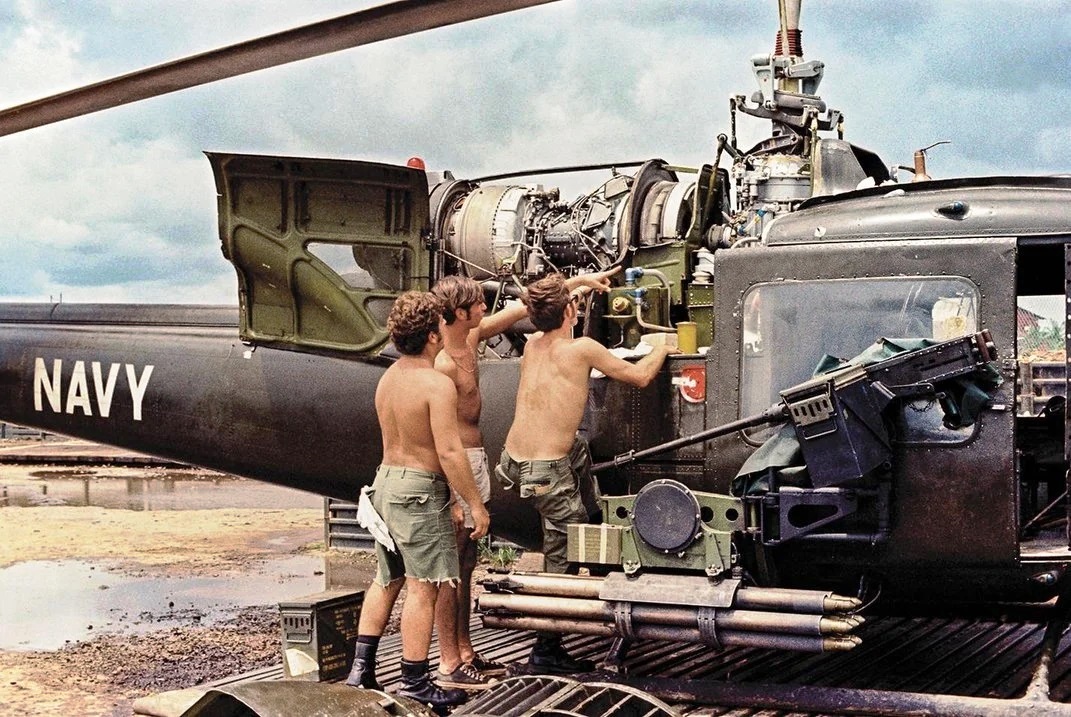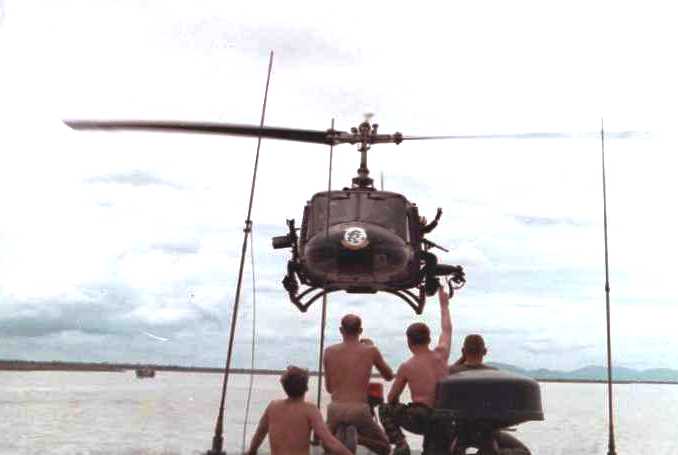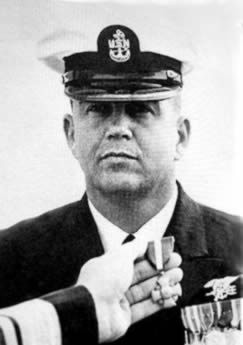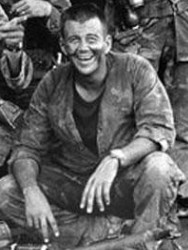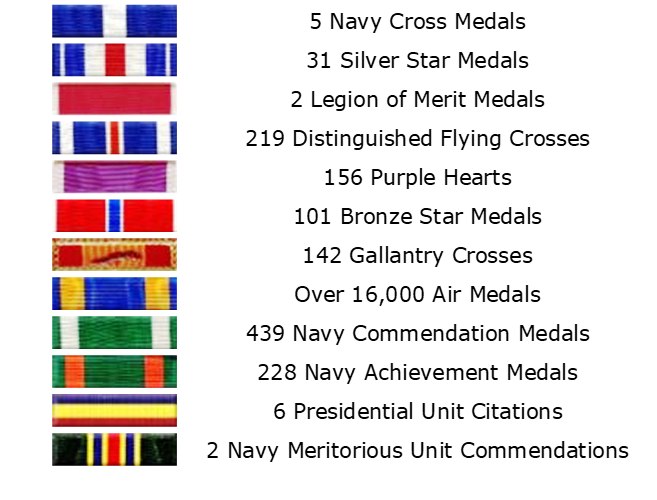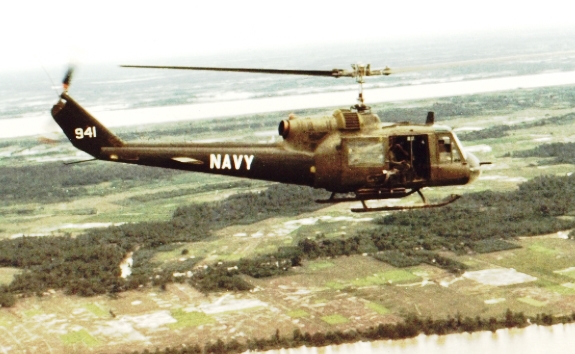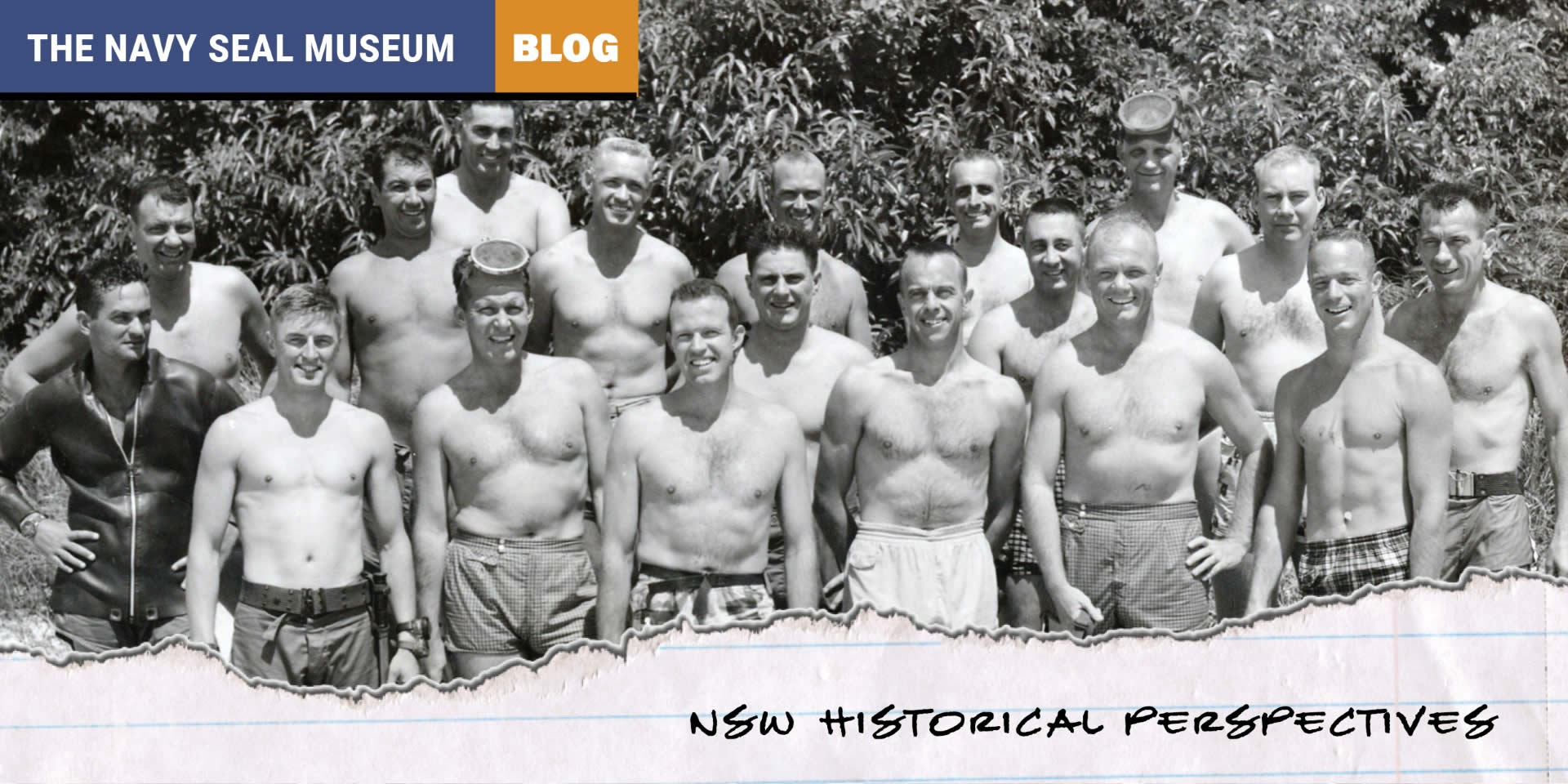
U.S. Navy “Seawolves”
South Vietnam 1966-1972
Most Decorated Navy Squadron of the Vietnam War
The Navy SEAL Museum has undertaken a project to refurbish a Bell UH-1B “Seawolves” helicopter for display on the grounds of the museum. Many will likely not know the story behind the helicopter squadron and their crews.
By early 1965 the Vietnam War was escalating at a rapid pace. Marines were making beach landings, and the U.S. Army’s air-mobile forces began extensive operations. It was determined by the Military Assistance Command, Vietnam (MACV) that something serious needed to be done to slow down enemy supply routes in the South China Sea, Gulf of Tonkin, and the Gulf of Siam. In March, a coastal-interdiction force named Operation Market Time was established. Working with the Vietnamese Navy, the U.S. Navy and U.S. Coast Guard launched new tactics with conspicuous success. In July, Coastal Surveillance Task Force 115 was activated and took command of all coastal interdiction operations.
During December 1965, Operation Game Warden was established as Task Force 116, with the intent of “denying the enemy the use of the major rivers of the Delta and the Rung Sat Special Zone.” To carry out its mission, TF-116 was assigned 120 PBRs (Patrol Boat, River), 20 LCPLs (Landing Craft, Personnel, Large), one LSD (Landing Ship, Dock), and helicopter gunship support provided by the U.S. Army.
During April 1966, the Army’s 197th Aviation Company began providing helicopters, aircrews, and maintenance support to CTF 116. This joint arrangement, however, was short lived; because the Navy wanted and needed direct control of air operations to support its river patrols. To alleviate the complexity of assigning Army helicopters for extended periods, need was created for a dedicated Navy helicopter squadron. As a result, Helicopter Support Squadron One (HU-1), based at Imperial Beach, California, was task to assume the mission. Also in April 1966, HU-1 was redesignated Helicopter Combat Support Squadron (HC-1) and organized into four new squadrons. On 30 August 1966, the Army withdrew and relinquished ownership of eight UH-1B helicopters to the Navy and provided training to HC-1 Navy crews in Vietnam.
One of the new HC-1 squadrons was Helicopter Attack Squadron (Light) THREE, HA(L)-3, named “Seawolves.” A Navy-wide message was broadcast requesting volunteer Naval Aviators to man HAL-3, and from the response, 80 pilots were chosen. HAL-3 was officially established at Vũng Tàu, South Vietnam in April 1967. Follow-on HAL-3 pilots and crews completed Army training at Fort Benning, Georga (UH-1B helicopter training) and Fort Bragg, North Carolina (gunship training). The squadron fell under the command of TF 116; and, within time, also began supporting Army-Navy Mobile Riverine Task Force (TF-117). The army extended its allocation of HU-1 helicopters to 22 by the end of 1967.
With heavily armed helicopters, HAL-3 missions included search and destroy patrols, armed reconnaissance, medical evacuation (MEDEVAC), CTF 116 and CTF 117 support, including SEALs. From its inception the squadron was designed as a quick-reaction force. Two gun-ship formations would stand alert for 24-hour shifts and respond to close-air support (CAS) requests up to 50 miles from their base. HAL-3 Detachments and SEAL platoons regularly operated out of the same home-base locations; allowing the men to personally interact face-to-face with one another.
The Bell helicopters provided by the U.S. Army were known as the “Huey.” The helicopter derived its nickname from the phonetic sound of its original designation, HU-1. The Museum’s UH-1B is an original flown by Seawolf pilots and crews in Vietnam. Information about the Museum’s refurbishment project can be found at: https://www.navysealmuseum.org/home-to-artifacts-from-the-secret-world-of-naval-special-warfare/seawolf-helicopter
SEALs and Seawolves
During Vietnam, everything was new for Navy SEALs. This included helicopter supported “air” capabilities, which were developed as elective methods of operation, that is, when helicopter support could actually be obtained. No helicopters were ever totally dedicated for SEAL operations during the Vietnam War; however, no discussion about SEALs in Vietnam would be complete without recognition that the Seawolves of HAL-3 never failed to support SEALs when needed.
With increasing necessity, Seawolves provided pre-mission and armed reconnaissance, gunfire support and insertion and extraction operations for SEAL squads and platoons. UH-1L Huey “Slicks,” called “Sealords,” were later added to the HAL-3 inventory. Sealord helicopters were intended primarily for logistic resupply operations; however, working in combination with Seawolves, they too conducted combat missions inserting and extracting SEALs. Indeed, SEALs and HAL-3 became a unique, inseparable, and a dominating warrior team in areas where they were co-located.
Best of the Best
“We Seawolves had a ‘Great’ mission.’ If it weren’t for the Seawolves and their sacrifices, many more names would be on this wall. Indeed, we Seawolves were the ‘Best of the Best.’ We dared to go when and where others would not go. People need not take our word for this. All they have to do is ask the units our squadron supported. Ask the ‘Brown Water Navy’ Sailors, including the SEALs and UDT. Ask the U.S. Army and Marine Corps Special Forces and advisors. Ask the Green Beret, LRP [Long Range Patrol], Mobile Strike Force, and Ranger Team members. Ask the South Vietnamese villagers who were in danger of being overrun by the VC and NVA.”
Tom Olby, HAL-3 Seawolves, Det 1 (1968-1971)
Vietnam Memorial Speech
Washington DC, 4 July 1996
Seawolves providing overwatch for river-patrol boats
Seawolves UH-1B helicopter gunship with distinctive logo
Seawolves UH-1B helicopter gunship with distinctive logo
Seawolves maintenance crew servicing their aircraft. Note rocket pod and door-mounted machine gun
Seawolf pilots strafing SEALs with low-level pass
“Scramble SEAWOLVES!”.
The Seawolves story was nicely characterize by Chief Gunners Mate Barry Enoch, a Vietnam veteran and highly decorated Navy SEAL, including the Navy Cross Medal. Master Chief Enoch is now deceased but completed a book in 1996 entitled: “Teammates: SEALs at War” about his platoon’s actions and activities in Vietnam. His quotation below can be found in the Forward introduction in the book “SEAWOLVES: First Choice,” By Daniel E. Kelly.
“Navy SEALs operated in Vietnam in commando units as small as four men and rarely more than fourteen. They penetrated deep into Viet Cong and North Vietnam Army strongholds to capture or eliminate the communist infrastructure. The SEALs were soon to become masters of camouflage, and were able to move through the jungle without detection and under the cover of darkness. Upon reaching their objective, they were often met with overwhelming odds. Then, the tip of the spear needed help from above, and radio silence had to be broken. The word went out: ‘Scramble Seawolves!’
“In Vietnam for maximum mobility and firepower over the jungles and rice paddies, the helicopter was the essential support vehicle for our riverine forces. The navy’s answer to the problem of SEAL support in an operating environment of unbroken jungle, rice paddies, or open water was the UH-1B helicopter gunship, call sign “Seawolf.” Mounted on each side of the Seawolves’s Huey helicopters were 2.75-inch rocket launchers, and two M-60 flex-mounted machine guns per side. Unique to the Seawolf gunships were its two gunners, one seated on each side of the helicopter with a freehand, shoulder-fired M-60 machine gun. These very special young gunners hung out of the helicopter with one foot on the rocket pod and fired to the side, under, and to the rear, as the gunship rolled in and out of an attack run.
“Not only does many a SEAL owe his life to the Seawolves, but the units often operated together as a team. Very often located at the same base of operations, we developed friendships that are still alive today. Operating well outside standard operating procedures, the Seawolves lifted many SEALs out of enemy encirclements, and I have known them to land in a hot LZ [Landing Zone], to lift out caches too large for the SEALs to pack out. The also evacuated our wounded, when MEDVAC [Medical Evacuation] helicopters were not available. Most important they were always there for us, when we were down in the mud and darkness; the night illuminated with red and green tracers; the VC behind every shadow. Many times, after we were out of danger, they stayed with us until we were safely extracted, in the middle of the river, and out of range of enemy fire.”
About HAL-3
HAL-3 was the only rapid-reaction armed-helicopter squadron ever commission in the U.S. Navy and remains the first and only squadron to be established and disestablished outside the United States.
At the height of their strength in 1971, HAL-3 fielded 29 UH-1B Huey gunships. They were supplemented by a smaller number of unarmed Huey “Iroquois” UH-1Ls, or “slicks,” which were used primarily for logistics flights.
In March 1972, after five years of continuous combat, HAL-3 was disestablished without fanfare at Binh Thuy. Their record of accomplishment is both astounding and commendable (*):
78,000 combat missions flown
131,000 flight hours
8,200 enemy killed
8,700 enemy vessels destroyed
9,5000 enemy structures destroyed
17,339 decorations or medals awarded
(*) Daniel E. Kelly
Though relatively unsung in the saga of the air war in Vietnam, HAL-3 was one of the war’s most highly decorated units. But they also suffered high casualties: 44 men killed and more than 200 wounded.
The men of HAL-3 were awarded:
Five Navy Cross Medals, 31 Silver Star Medals, two Legion of Merit Medals, 219 Distinguished Flying Cross Medals, 156 Purple Hearts, 101 Bronze Stars, 142 Vietnam Gallantry Cross Medals, over 16,000 Air Medals, 439 Navy Commendation Medals, 228 Navy Achievement Medals, six Presidential Unit Citations, and two Navy Meritorious Unit Commendations.
Or
More information about Seawolves can be found at: https://seawolf.org/command-history/
Books about Seawolves:
SEAWOLVES: FIRST CHOICE, by Daniel E. Kelly
U.S. Navy Seawolves: The Elite HAL-3 Squadron in Vietnam, by Daniel E. Kelly
Seawolf 28: A True Story, by Al Billings
Triumphant WARRIOR: The Legend of the Navy’s Most Daring Helicopter Pilot, by Peter D. Shay.
Fire from the Sky: Seawolf Gunships in the Mekong Delta, by Richard Knott
More at: https://seawolf.org/resources/references/
Note: In various books and writings the HAL-3 squadron name is spelled Seawolves. When referring to individual pilots, their call sign is spelled as Seawolf (as in the book title “Seawolf 28” above). The Seawolf Association and domain name uses “seawolf.org,” while the website banner uses: U.S. NAVY SEAWOLVES.
Note: My platoon in Vietnam operated out of the Nhà Bè Navy Base, which was in the northern part of the Rung Sat Special Zone and about 22 miles southeast of Saigon. We were collocated with HAL-3, Detachment 2 about which enough admiration and praise cannot be given – very, very special officers and men.

